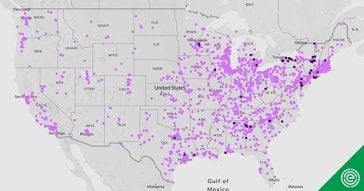
The Environmental Working Group (EWG) reviewed two online databases from the U.S. Environmental Protection Agency, as well as data from a survey by the state of New York, and identified 2,501 unique industrial sites that are known to produce or use PFAS, or that are suspected of using PFAS. This count of industrial sites does not include public water systems or military installations with known or suspected PFAS contamination, but many of the industrial sites identified in the analysis closely correlate with the known contamination sites previously mapped by EWG. Some of these sites have already been confirmed as a source of drinking water contamination, but not all tap water near listed facilities may have been tested.
Until recently, chemical companies have not been required to report industrial releases of PFAS through the federal Toxic Release Inventory (TRI). Of the 2,500 newly identified industrial facilities, EWG found that 2,467 of them are already reporting other toxic chemical releases through the TRI. Last year, Congress included a provision in must-pass legislation that will add 172 PFAS to the TRI, but that reporting will not start until next year. There are no restrictions currently on industrial PFAS discharges or pretreatment requirements under the federal Clean Water Act. In many communities, industrial discharges of PFAS are the most significant source of PFAS pollution entering drinking water supplies.
In January, the U.S. House of Representatives passed the PFAS Action Act (H.R. 535), which would establish deadlines for the EPA to determine how to regulate industrial discharges of PFAS under the Clean Water Act. These new provisions include effluent limitations and pretreatment standards, require permit before discharging, and prohibit the indirect discharge of industrial PFAS in to wastewater treatment plants. A similar version of these provisions was also included in the Moving Forward framework for infrastructure legislation released by House Democrats in January.

